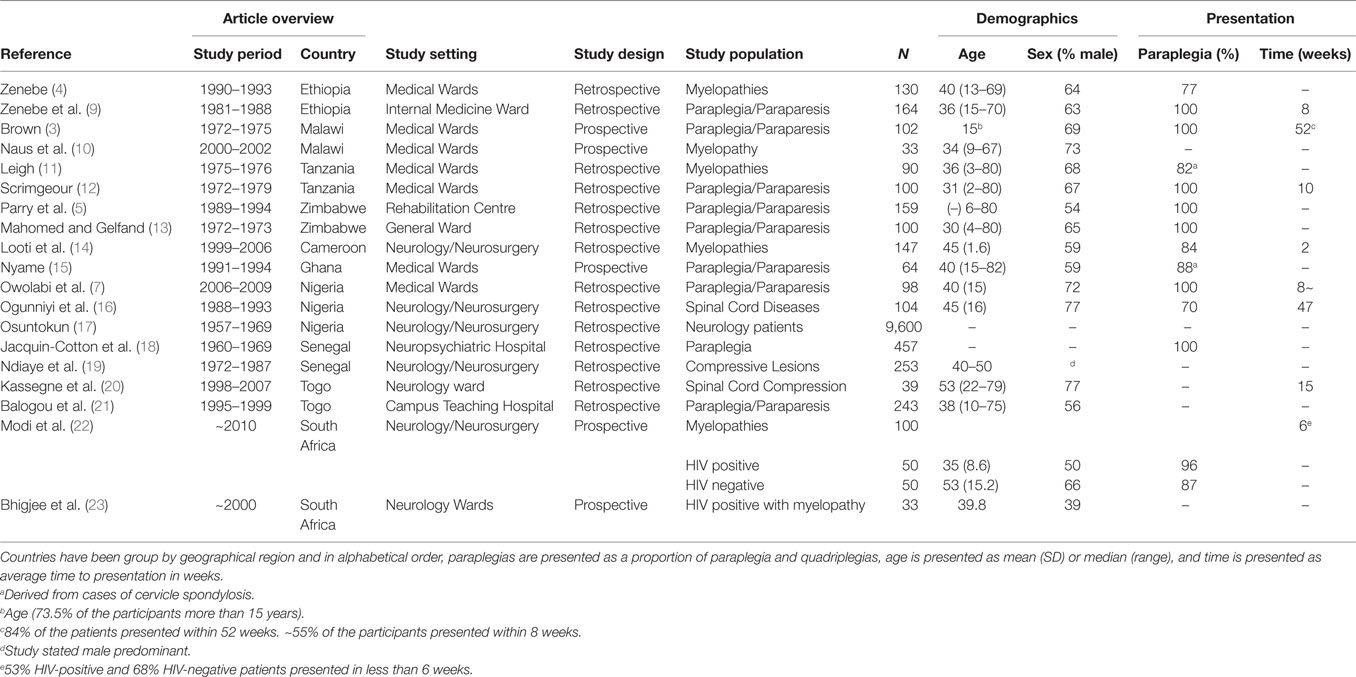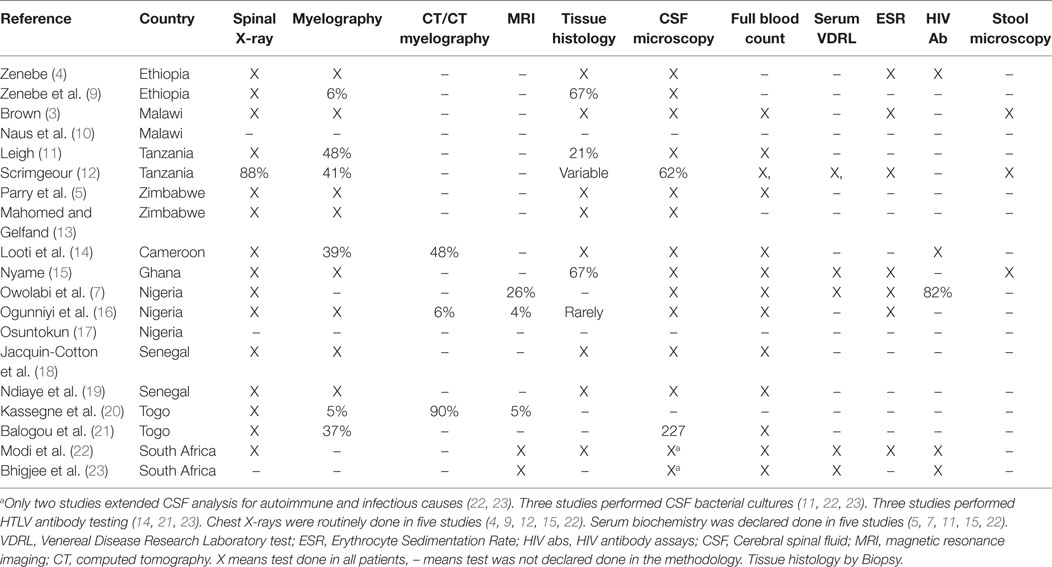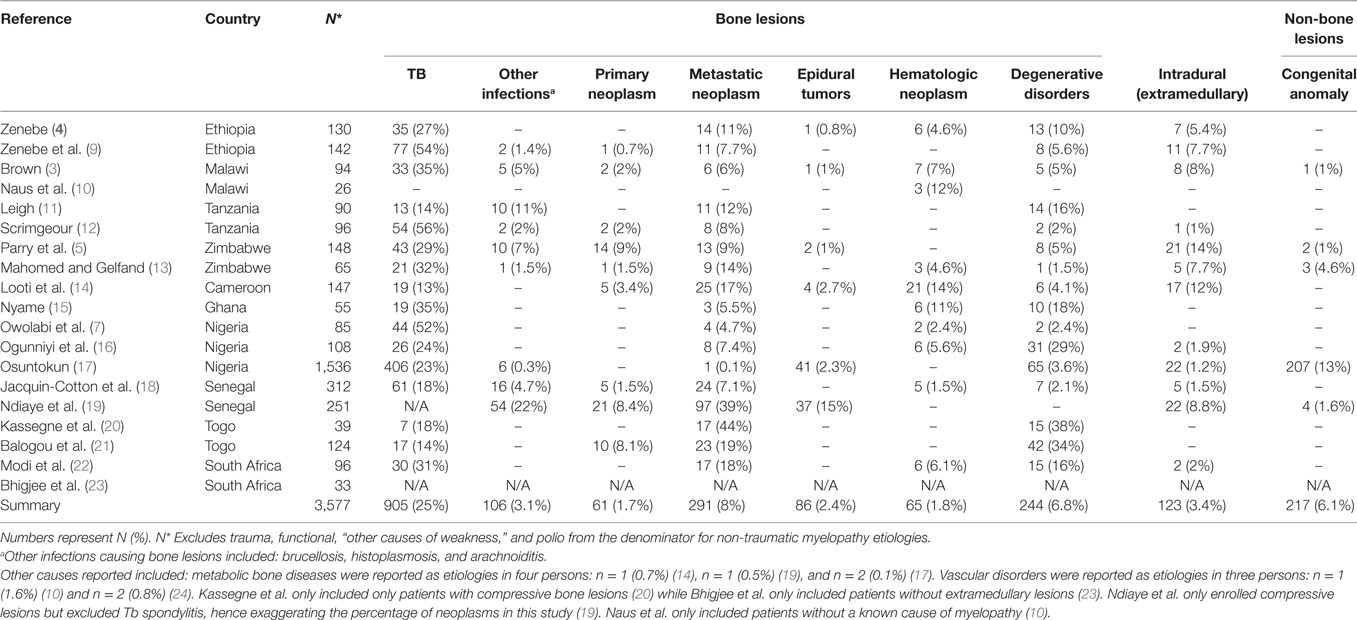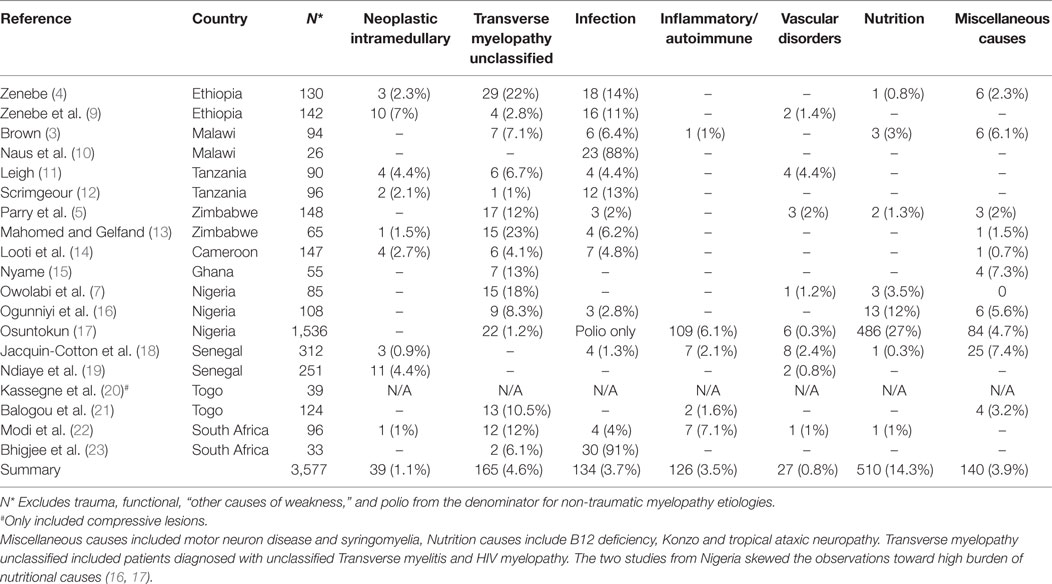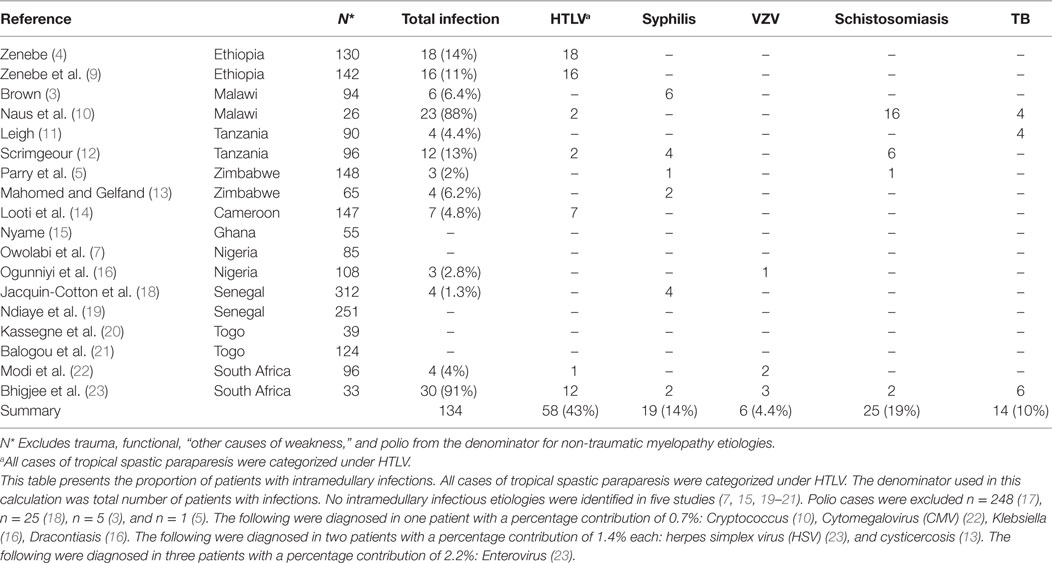- 1College of Health Sciences, Infectious Disease Institute, Makerere University, Mulago Hospital Complex, Kampala, Uganda
- 2Medicine, Mulago National Referral Hospital, Mulago Hospital Complex, Kampala, Uganda
- 3Medicine, College of Health Sciences, Makerere University, Mulago Hospital Complex, Kampala, Uganda
- 4Division of Infectious Diseases and International Medicine, Medicine, University of Minnesota, Minneapolis, MN, United States
- 5Neurology, University Teaching Hospital of Kamenge, Bujumbura, Burundi
- 6Neurology, Yale University, New Haven, CT, United States
Background: Non-traumatic myelopathy is common in Africa and there are geographic differences in etiology. Clinical management is challenging due to the broad differential diagnosis and the lack of diagnostics. The objective of this systematic review is to determine the most common etiologies of non-traumatic myelopathy in sub-Saharan Africa to inform a regionally appropriate diagnostic algorithm.
Methods: We conducted a systemic review searching Medline and Embase databases using the following search terms: “Non traumatic spinal cord injury” or “myelopathy” with limitations to epidemiology or etiologies and Sub-Saharan Africa. We described the frequencies of the different etiologies and proposed a diagnostic algorithm based on the most common diagnoses.
Results: We identified 19 studies all performed at tertiary institutions; 15 were retrospective and 13 were published in the era of the HIV epidemic. Compressive bone lesions accounted for more than 48% of the cases; a majority were Pott’s disease and metastatic disease. No diagnosis was identified in up to 30% of cases in most studies; in particular, definitive diagnoses of non-compressive lesions were rare and a majority were clinical diagnoses of transverse myelitis and HIV myelopathy. Age and HIV were major determinants of etiology.
Conclusion: Compressive myelopathies represent a majority of non-traumatic myelopathies in sub-Saharan Africa, and most were due to Pott’s disease. Non-compressive myelopathies have not been well defined and need further research in Africa. We recommend a standardized approach to management of non-traumatic myelopathy focused on identifying treatable conditions with tests widely available in low-resource settings.
Background
Non-traumatic myelopathy is a challenging condition to manage because of the wide differential diagnosis and substantial regional variation (1, 2). This condition is thought to be more common in Africa than in Europe (3). In Sub-Saharan Africa, non-traumatic myelopathy is associated with a high morbidity (about 50% persistent disability) and mortality (around 10% in admission) and has important economic repercussions for patients and health systems (4–7).
Advanced diagnostics, such as the magnetic resonance imaging (MRI) and several cerebrospinal fluid (CSF) studies, are not readily available in many settings in Sub-Saharan Africa. Thus, standard of care diagnostic approaches for the evaluation of patients presenting with non-traumatic myelopathy developed in resource-rich settings are not applicable to primary care settings in sub-Saharan Africa. Recent reviews of spinal cord injury have focused on descriptive epidemiology and have not been structured so that they can inform a diagnostic approach to non-traumatic myelopathy (1, 2). The objectives of this review were to describe the causes of non-traumatic myelopathy from sub-Saharan Africa and develop an evidence-based diagnostic algorithm for the evaluation of patients that present with non-traumatic myelopathy in resource-limited settings.
Methods
We conducted a systematic review designed to identify studies describing the epidemiology of non-traumatic spinal cord injury/myelopathy in Sub-Saharan Africa (8). We searched the Medline and Embase database using Ovid to identify peer-reviewed manuscripts describing the epidemiology and etiology of non-traumatic spinal cord injury, myelopathy, paraplegia, and quadriplegia in a general outpatient or inpatient clinical population. Search terms were: 1. paraplegia.mp; 2. quadriplegia.mp; 3. myelopa*.mp; 4. spinal cord.ab; 5. spinal cord.mp; 6. (1 or 2 or 3 or 4 or 5); 7. exp Africa/; 8. (6 and 7); 9. polio.mp; and 10. (8 not 9). Records were then reviewed for inclusion/exclusion based on title, then abstract, and then full-text. Inclusion criteria were as follows: (i) study conducted in Africa, (ii) published before 1 January 2015, (iii) reports more than one etiologic agent, and (iv) described the etiology of non-traumatic myelopathy in a general clinical population by disease process. Exclusion criteria were as follows: (i) study only included children <12 years of age, (ii) could not calculate the frequency of each etiology with data provided in the manuscript, (iii) study included less than 30 individuals, (iv) sample identified from a record review of imaging studies, or (v) studies exclusively focused on radiological or anatomical terminology, and (vi) study conducted outside Sub-Saharan Africa. Two authors (Abdu Kisekka Musubire and Ana-Claire Meyer) independently reviewed the list of titles and abstracts and selected manuscripts for inclusion. Any discrepancies were discussed until consensus was reached. Data on clinical setting, study methods, diagnostic investigations, and frequencies of etiologies were abstracted from the manuscripts (Abdu Kisekka Musubire).
Statistical Analysis
We described the proportion of etiologies of non-traumatic myelopathy and summary averages were calculated from the weighted mean with 95% confidence interval (95%CI). We excluded polio infection, trauma, somatoform disorders, or diagnosis not localizing to the spinal cord and roots.
Subsequently, a diagnostic algorithm was generated focusing on identifying the most common treatable causes in this region. Other considerations were efficient triage of patients that should be treated by other clinical services such as neurosurgery or orthopedics and the cost and availability of diagnostic tests in typical sub-Saharan African hospitals.
Results
We identified 19 studies (Figure 1) that met our selection criteria. These studies were primarily retrospective, occurred over a large time span (1970–2010) and were conducted predominantly in inpatient tertiary centers in variety of settings including medical, neurological, and neurosurgical wards (Table 1). Only 10 of the 54 countries that comprise the African continent were represented. Most of the studies were done in the West African region (9/19), followed by the East African region (8/19) and only two studies from the South African region. Most of the studies were retrospective (15/19) case series. Only 5 studies specifically focused on myelopathy with the majority covering paraplegia/paraparesis. Several studies (6/19) had less than 100 participants.
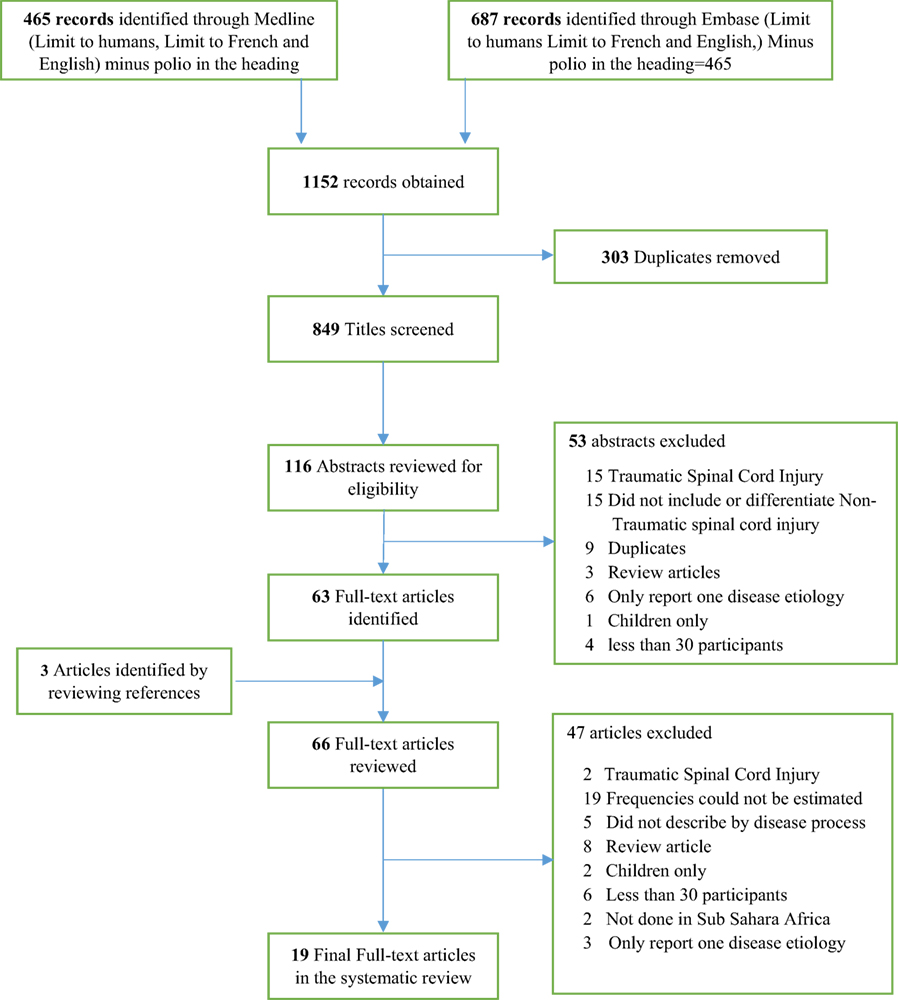
Figure 1. Search strategy in Medline and Embase using OVID search strategy. Flow diagram of the Search strategy through OVID in both the Medline and Embase database going through the selection criteria.
Among individuals presenting with non-traumatic myelopathy, there was male preponderance and the average age at presentation increased over time, from an average age in the third decade in the 1970s (11, 12) to the fourth decade in the 1990s and 2000s (7, 16). HIV-infected individuals with non-traumatic myelopathy were younger than HIV-negative patients (22, 23). More than 80% initially presented with paraplegia/paresis (14, 22), and more than 40% presented with a complete transverse myelopathy (involvement of the motor, sensory, and autonomic dysfunction) (3, 22).
There was a striking delay from symptom onset to presentation for clinical care in most studies; for example, only 53–68% of patients in South Africa presented within 6 weeks of onset (22). In Tanzania, the mean delay was 8 weeks (12), while in Nigeria and Ethiopia approximately 50% of the patients presented between 8 and 16 weeks after symptom onset (4, 7, 9).
Diagnostic Approach
In general, the diagnostic approach within each study was not uniform and there were few diagnostics available. Thus, most diagnoses were presumptive or based on clinical criteria (Table 2). Plain radiographs of the spine were used in nearly all studies and were helpful in diagnosing tuberculous osteomyelitis of the vertebrae, or Pott’s disease, and malignancies that cause compressive bone lesions. In a few recent studies, advanced imaging was used; three studies documented the use of CT and five studies an MRI. However, even when CT or MRI was used in a study, only a small proportion of patients were able to access these modalities. This is likely because most studies were derived from retrospective clinical case series where the costs of advanced imaging are borne by the patient and, thus, only those able to afford the study are able to obtain them.
Cerebrospinal fluid microscopy was commonly employed, though only two studies from South Africa were able to perform more comprehensive evaluations for infections, including microbial cultures or polymerase chain reaction (PCR) testing. A few studies did stool and urinalysis in search of schistosomiasis. Several studies from neurosurgical units had histological diagnoses, as they were drawn from samples of surgical cases with biopsies.
Etiology
Our initial approach to categorizing etiologies of non-traumatic spinal cord injury/myelopathy was drawn from consensus guidelines published by the International Spinal Cord Injury (ISCI) group (24). However, the ISCI approach relies heavily on MRI that was not generally available in the studies we reviewed. Thus, we adapted the ISCI approach for a sub-Saharan African setting as follows. The diagnoses were initially grouped into three broad categories: extramedullary or compressive, intramedullary or non-compressive, and unclear etiology (Table 3). We then categorized extramedullary or compressive lesions into bone or non-bone compressive lesions on the basis of plain radiographs of the spine, myelogram, and the stated diagnosis in the reviewed publication. Finally, we identified etiologies of intramedullary or non-compressive lesions based on laboratory evaluation.
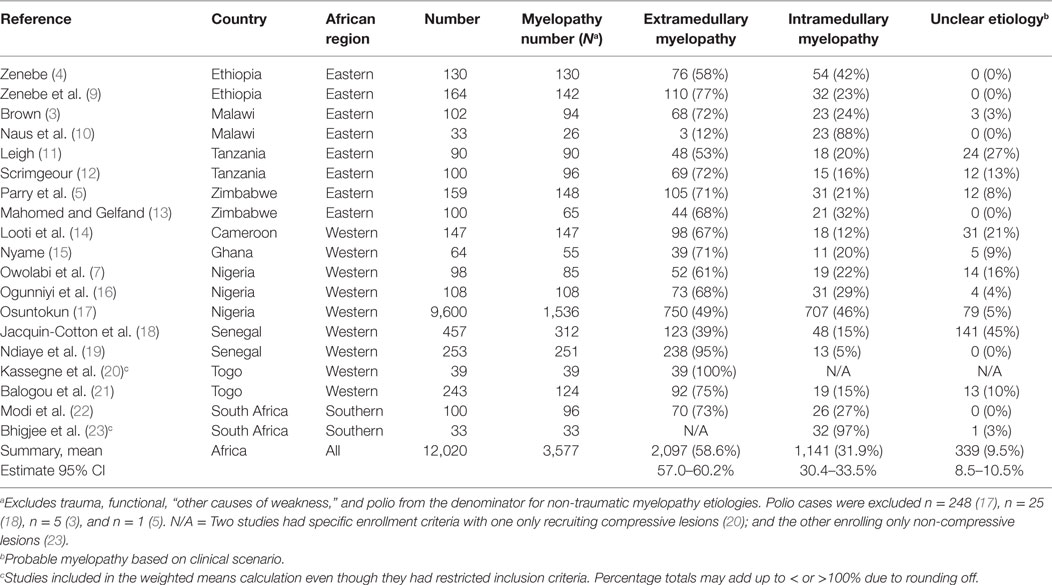
Table 3. Common diagnosis according to classification of the causes of Non-traumatic spinal cord injury in Sub-Saharan Africa.
In total, we found over 200 different etiologies described in the included studies (Appendix S1 in Supplementary Material) though this was dependent on the availability of diagnostics. The different etiologies were then grouped in different categories (Appendix S2 in Supplementary Material). Extramedullary lesions constituted a weighted average of 58.6% (range: 12–95%) (Table 4). Compressive bone lesions made up the majority of cases of non-traumatic myelopathy in Africa with a weighted average of 49.1% (range: 12–83%) while non-bone compressive lesions constituted 9.5% (range: 0–16%) of the lesions (Table 4). Nearly 31.9% (range: 5–97%) had non-compressive lesions and no definitive diagnosis was identified in 9.5% (range: 0–45%) (Table 3). A clinical diagnosis of transverse myelopathy unclassified was the most common cause of non-compressive lesions at 4.6% (range:1–23%) (3, 5, 11, 14, 15). Typically, a diagnosis of transverse myelitis was based on lack of a compressive lesion visualized on plain radiograph and inflammatory CSF. Importantly, the underlying causes of transverse myelitis were not identified in most studies.
Compressive Lesions
The most common causes of compression were Pott’s disease and tumors (Table 4). Pott’s disease caused 25% of non-traumatic myelopathies (range 13–54%) and 50% of compressive bone lesions. The diagnosis was typically based on finding anterior wedging of the vertebral body on plain radiograph. The clinical presentation of Pott’s disease in these studies differed somewhat from traditional teaching. For example, in a study by Zenebe et al. from Ethiopia, few patients presented with constitutional symptoms such as weight loss and fever that are typically associated with disseminated tuberculosis though 30% of the patients had TB at other sites as well (9). The most common presentation of Pott’s disease in this study was gradual onset of weakness in the legs (92%), vertebral deformity (88%), and vertebral tenderness (88%) (9). Occasionally, individuals reported sudden onset of paraplegia (7.8%) (9).
The weighted average proportion of non-traumatic myelopathies explained by neoplasms that included primary bone neoplasms, metastatic disease, epidural tumors, hematological neoplasms, unclassified intradural, and intramedullary tumors was 18.6% (range 0–75%). The proportion of neoplasms varied depending on the source of the study population. Neoplasms were found at frequencies as high as 49% in a neurology/neurosurgical unit in Cameroon (14), 28% in a neurorehabilitation Centre in Zimbabwe (5) to between 13 and 25% in most studies done on medical/neurological wards (4, 11, 12, 15). HIV prevalence may also contribute to this heterogeneity; in a South African study, HIV-uninfected individuals had a higher proportion of neoplasms than an HIV-infected group (22). Neoplasms were also more frequent in older age groups and presented at a mean age about 50 years (9, 12).
When differentiated from primary tumors, metastatic disease was the second most common cause of compressive bone lesions, representing a weighted average of 8.1% of non-traumatic myelopathies (range 0–44%). Prostatic carcinoma was the most common primary tumor reported in Malawi (3), South Africa (22), and Nigeria (7) while lymphoma was the most common primary tumor in studies from Cameroon and Ghana (14, 15). Hepatocellular carcinoma was predominant in studies from Cameroon (14) and Ethiopia (9). The high proportions of cases of hepatocellular cancer in these regions have been attributed to the high endemicity of hepatitis B (14). Other common primary tumors identified were from the lung and breast (14).
Primary spinal and vertebral tumors were reported less frequently than metastatic disease and ranged from 0 to 20% with a weighted average of 4.6% (9, 11). The most frequently reported tumors were nerve sheath tumors (Schwannoma, neurofibroma, and meningioma) and plasmocytoma (3, 14). Other primary tumors including lipoma, medulloblastoma, and ependymoma were rarely reported (9).
Infections other than tuberculosis that resulted in compressive lesions were less frequently reported. Spinal epidural abscess was only reported (1%) of patients (3). Brucella spondylitis has also been described (9), presenting with a variety of presentations from myelitis to epidural abscesses to spondylitis. Two cases of Cysticercosis and one case of blastomycosis were observed in Zimbabwe (13) and one report of actinomycosis was reported in Tanzania (12).
Degenerative bone disease was infrequently reported and the weighted average was 6.8% (range: 2–38%). Cervical spondylosis occurred more frequently in HIV-negative and older individuals more than 50 years old (14, 22).
Non Compressive Lesions
Intramedullary spinal cord lesions, which are non-compressive, constituted 31.9% (range 5–97%) of non-traumatic myelopathies (Table 5). In Western Africa, the majority of intramedullary lesions were suspected to be myelopathy from an as yet undefined nutritional cause. However, in many areas, a clinical diagnosis of transverse myelopathy is the most common cause.
Intramedullary infections are presented in Table 6. Human T-Lymphotropic Virus 1 (HTLV-1) myelopathy was the most common infection identified in individuals with non-traumatic myelopathy with the following proportions 9.8% in Ethiopia (9), 4.8% in Cameroon (14), and was lowest at 1% in South Africa (22). In studies from Ethiopia (4, 9), Tanzania (12), and Malawi (10), the diagnosis was based on a characteristic clinical presentation of insidious, slowly, and chronically progressive spastic paraparesis, without remission or acute on chronic episodes, frequently associated with paresthesia and hypoesthesia of the lower limbs, lumbago, and sphincter dysfunctions. Some studies based diagnoses on serology (14, 22). A study from South Africa showed 12 (36%) of the patients had HIV/HTLV-1 coinfection (23).
Neurosyphilis was identified in three studies: 6% of patients from Malawi (3), 4% from Tanzania (12), and 0.6% from Zimbabwe (5). The diagnosis was typically based on a positive CSF Venereal Disease Research laboratory test (7, 15) but also on MRI showing multiple enhancing granulomata of the cord or as a differential in patients with arachnoiditis (23).
Schistosomiasis due to Schistosoma mansoni most commonly affects the conus medullaris and cauda equine (23). There are multiple individual case reports of acute paraparesis in returning travelers from high-income countries where Schistosoma ova have refluxed into the vertebral venous system, become lodged, and generated an inflammatory reaction, mimicking transverse myelitis. Yet, the attributable burden of Schistosomiasis toward non-traumatic spinal cord disease in Sub-Saharan Africa is less clear. Studies used widely differing diagnostic criteria ranging from residing in an endemic area with no other obvious cause of myelopathy, microbiological confirmation of systemic disease, Schistosoma CSF serology to MRI findings suggestive of schistosomiasis. One study from Tanzania found that 6% of individuals with non-traumatic spinal cord injury had Schistosoma eggs in urine, stool, and rectal snips (12). Schistosomiasis was mentioned in one patient in Zimbabwe (5). Nau et al. in Malawi diagnosed 16 out of 33 patients with schistosomiasis based on immunodiagnostic methods in an endemic region (10). It was diagnosed in two patients in South Africa based on MRI findings of the lumbosacral spine showing enhancement of the roots and a swollen conus with hyperintensity on T2-weighted MRI. One had a peripheral eosinophilia and dramatically improved on praziquantel (23).
Two studies from South Africa noted that HIV vacuolar myelopathy was found in 1–6% of patients; diagnosis was based on low CD4+ T-cell count, high HIV viral load, MRI that showed hyper-intense signals on T2 signal intensity in the dorsal and lateral columns, and exclusion of other causes of myelopathy (22, 23). HIV myelopathy has been described in 3–16.9% of patients with myelopathy in Ethiopia and South Africa (9, 23). Other studies that did not have access to advanced imaging defined HIV myelopathy as an HIV positive patient with no other cause of myelopathy identified. In these studies, the proportion of myelopathy patients with HIV infection ranged from 14.1% in Nigeria (7), 30% in Ethiopia (9), to 50% in South Africa (22). This mirrors the prevalence of HIV in the general population.
The other infectious causes that were identified included cytomegalovirus infection (CMV) (one patient) and varicella zoster (two patients) (22). The diagnosis of varicella myelitis was suggested by the presence of a rash. Other infections described included herpes simplex and enterovirus (23). Tuberculosis (six patients) was also described and presented as a non-specific myelopathy with CSF findings suggestive of Tuberculous meningitis or with extensive lymphadenopathy (23).
Autoimmune causes of transverse myelitis were only defined in detail in one study by Modi et al. In a population of 100 patients, 4 HIV-infected patients had acute demyelinating encephalomyelitis diagnosis based on spine and Brain MRI, one had systemic lupus erythematosus, and two HIV-infected patients had presumed neuromyelitis optica based on imaging and CSF findings only. In the same study, four HIV-negative patients were diagnosed with idiopathic transverse myelitis (22).
Vascular, metabolic, nutritional, and other causes for non-traumatic spinal cord injury were relatively rare and no consistent testing was performed in most studies. Spinal cord infarction was confirmed in one patient from South Africa (22), two post-partum mothers in Zimbabwe (5), one in Nigeria (7), one in Ethiopia (9), and in 4% of the patients in Tanzania (11). Metabolic conditions were not reported in most of these studies but potential etiologies include Konzo, neurolathryism, and B12 deficiency. There is literature about Konzo due to cassava consumption in Mozambique, Tanzania, Democratic Republic of the Congo, and Central African Republic (25–30). Konzo is diagnosed by its epidemiologic pattern, nutritional habits in addition to serum and urine thiocyanate concentrations (27). Neurolarythrism due to ingestion of Lathyrus sativus plant has been described in Ethiopia (28, 31–33). Vitamin B12 deficiency has been described in a 1–3% of the patients in South Africa, Cameroon, Nigeria, and Malawi (3, 5, 7, 14, 22). There is a reported suspected nutritional causes of myelopathy in large numbers of patients from Nigeria (16, 17).
Other Conditions
A condition classified as miscellaneous causes like motor neuron diseases and syringomyelia constituted only a weighted average of 3.9% range 0–7.4% of the patients (3, 5, 15).
Proposed Diagnostic Algorithm for Non-Traumatic Spinal Cord Injury in Resource-Limited Settings
As we reviewed the results of our systematic review in detail, we noted several findings with important implications for a diagnostic algorithm:
1. Age: younger patients are more likely to have an unknown cause or tuberculosis as the cause of their myelopathy while older patients are more likely to have metastatic tumors or degenerative conditions (Figure 3).
2. HIV: HIV-infected patients tend to be younger than HIV-negative patients and are more likely to have infectious etiologies (22, 23).
3. Availability of diagnostics: plain radiographs of the spine, HIV antibody testing, erythrocyte sedimentation rate (ESR), and full hemogram were widely available and generally affordable for patients. Alpha fetal protein and prostatic-specific antigen were also frequently available.
4. Role of ESR: the role of ESR is debated but has been found consistently raised in Potts disease (4, 16).
5. Most common etiologies: Pott’s Disease and metastatic disease are the most common causes of compressive lesions and transverse myelitis of unclear etiology is the most common cause of non-compressive lesions.
6. Cost of diagnostic modalities: the average cost of an MRI in Uganda is 200 USD in a country with a GDP of 714.6 USD and the total expenditure on health as % for GDP (2014) was 7.2%. The health expenditure per capita was 52 USD well below what would be required to investigate such a patient.
7. Availability of treatment: the available treatments include. Anti-tuberculosis medications, Vitamin B12 supplementation, steroids, radiotherapy, anti-cancer drugs, and surgical resection.
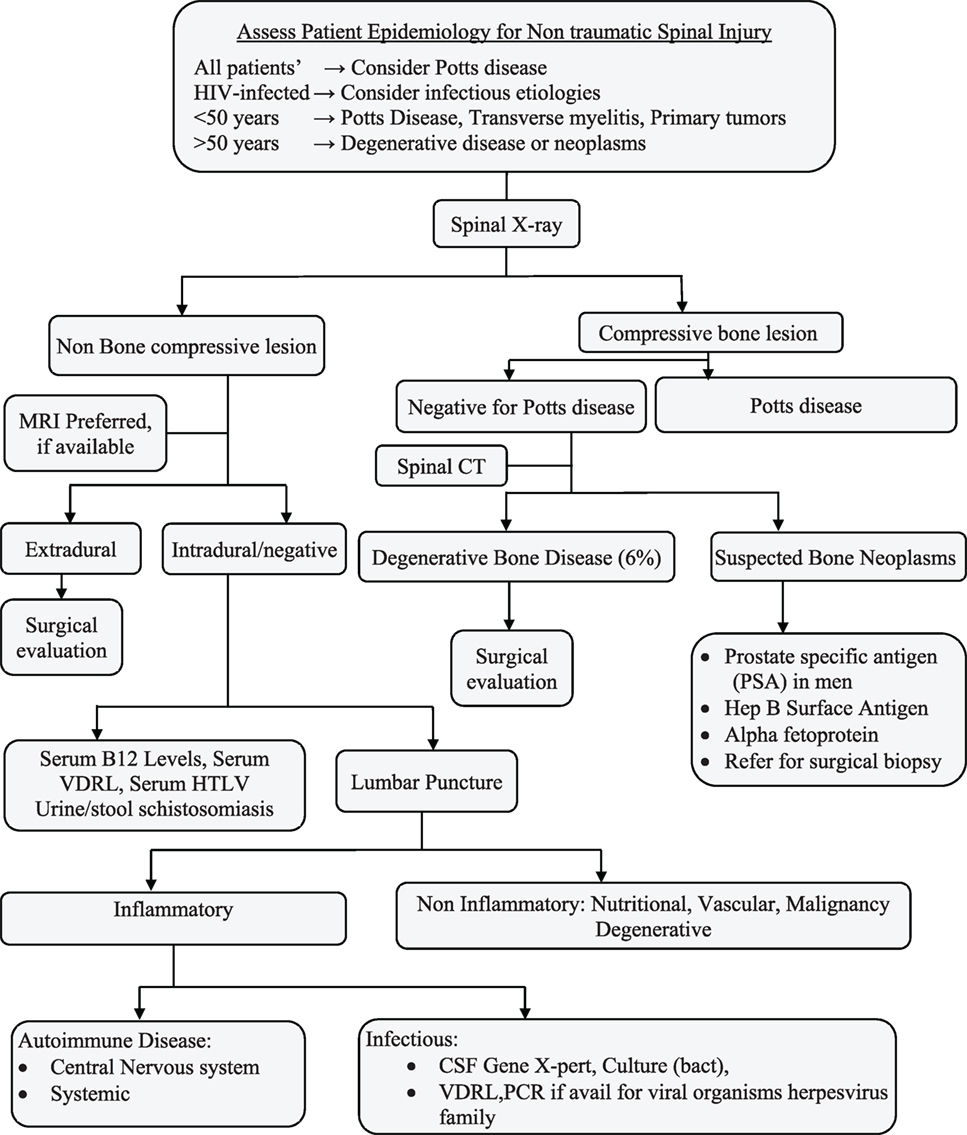
Figure 2. Proposed diagnostic algorithm for non-traumatic spinal cord injury. Proposed diagnostic Algorithm of a patient who presents with non-traumatic myelopathy from the first contact with the health system in the sub-Saharan Africa. CT, computerized tomography; MRI, magnetic resonance imaging; VDRL, Venereal Disease Research Laboratory; PCR, polymerase chain reaction; CSF, cerebral spinal fluid; Hep B, hepatitis B antigen.
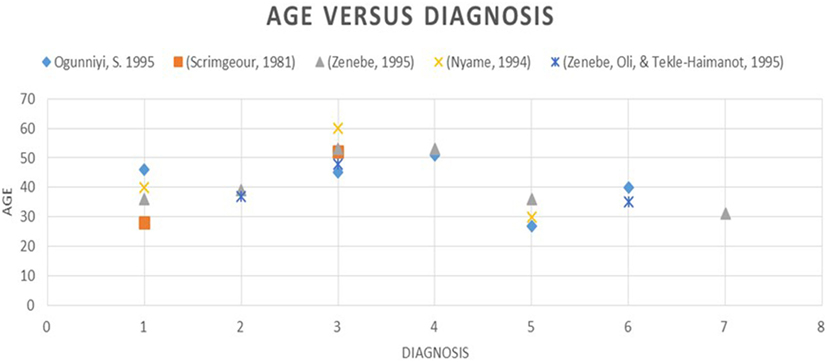
Figure 3. The graph shows age versus diagnosis: 1, TB; 2, primary tumors; 3, metastatic disease; 4, degenerative conditions; 5, TM; 6, HIV myelopathy.
We propose the following algorithm presented in Figure 2.
Step 1
Screening
History and Examination. Spinal cord disorders may present with any combination of the signs and symptoms below:
a. Motor deficits: weakness in the limbs, may be symmetric or asymmetric; typically involves both legs, or both legs and both arms together. This is usually accompanied by increased tone, brisk reflexes, clonus, or present Babinski sign (up going toe).
b. Sensory deficits: lack of sensation (numbness to touch, temperature, and for advanced practitioners to vibration or position sense) or abnormal sensations (parasthesias/tingling). Like the motor deficits, the sensory deficits may be symmetric or asymmetric; typically involves both legs, or both legs and both arms together. There may be a distinct level on the trunk below which the patient does not have sensation.
c. Autonomic nervous system deficits: there may be urinary retention with overflow incontinence, fecal constipation or incontinence, and erectile dysfunction. In very severe cases, there may be paralysis of the muscles of respiration or orthostatic hypotension.
Step 2
Localize the Lesion
It is of the utmost importance to roughly localize the lesion, so that appropriate imaging studies can be ordered. Because damage to the spinal cord, may be patchy, our clinical examination can only show us the lowest possible spinal level affected. For example, if someone has weakness and sensory loss in both legs, the lesion could be in the lumbar, thoracic, or cervical cord. By contrast, if someone has both arm and leg weakness and sensory loss, the lesion can ONLY be in the cervical cord or above.
1. Lumbar/thoracic/cervical: only legs are affected; may have no sensory level on the trunk.
2. Thoracic/cervical: legs are affected, may have a sensory level on the trunk.
3. Cervical: arms and legs are affected.
Step 3
To further evaluate the patient, please refer to Figure 2.
Discussion
In most of the studies, diagnosis was based on clinical evaluation and on plain radiograph and only in few studies advanced imaging in form of CT/MRI done. However, plain X-rays are limited in the diagnosis of non-compressive myelopathy and other infective etiologies with the exception of Potts disease. Compressive myelopathy of bony lesion was most common etiology and transverse myelopathy of unclassified group were common in non-compressive lesion group.
Pott’s disease is one of the most common causes of non-traumatic myelopathy in sub-Saharan Africa. Tumors, both primary and metastatic, are also common though this may be somewhat biased as several studies were taken from neurosurgical case series (3). Nonetheless, a specific etiology cannot be identified in a large proportion of individuals with non-compressive lesions though most studies had limited investigative capacity. Vascular anomaly of spinal cord cases was missing. In the group of non-compressive lesion, evaluation for vasculitis to be considered. To improve care for individuals with non-traumatic myelopathy in resource-limited settings, there is an urgent need to increase availability of laboratory tests that can identify treatable causes of myelopathy, such as neurosyphilis, HTLV, HSV, VZV, and B12 deficiency. Additional research to better understand the causes of non-traumatic myelopathy in sub-Saharan Africa, especially the treatable causes, is critical to improve care and outcomes from this disorder.
A simple algorithm has the potential to more efficiently triage and evaluate patients in low-resource settings and can assist primary health care providers and non-neurologist physicians in the management of these patients. To improve capacity for the care of patients with non-traumatic myelopathy, it will also be essential to train primary health care providers in neurology, increase post-graduate neurology training opportunities, and increase availability and affordability of MRI and laboratory tests. Raising awareness so that patients present for medical care for non-traumatic myelopathies more quickly will also be important to improve outcomes from this disorder.
Author Contributions
AKM participated in the study conception, design, data aquisition, data analysis, drafting, revision, final approval, and agreement. DM participated in the study design, data aquisition, revision, final approval, and agreement. PB participated in the study conception, design, revision, final approval, and agreement. EK participated in the study conception, revision, final approval, and agreement. PB participated in the data aquisition, data analysis, drafting, revision, final approval, and agreement. DB participated in the study conception, design, data analysis, drafting, revision, final approval, and agreement. ALM participated in the study design, data aquisition, data analysis, drafting, revision, final approval, and agreement.
Conflict of Interest Statement
The authors declare that the research was conducted in the absence of any commercial or financial relationships that could be construed as a potential conflict of interest.
Acknowledgments
This work was supported in part by the NIH Fogarty International Center (R25TW009345), NIH grant K24 AI096925, and the Division of Infectious Diseases and International Medicine at the University of Minnesota Dr. Meyer was supported by Fogarty International Center of the National Institutes of Health [K01TW008764]. The authors thank Mr. Mark Gentry at the Yale University Library.
Supplementary Material
The Supplementary Material for this article can be found online at http://www.frontiersin.org/article/10.3389/fneur.2017.00618/full#supplementary-material.
References
1. New PW, Cripps RA, Bonne Lee B. Global maps of non-traumatic spinal cord injury epidemiology: towards a living data repository. Spinal Cord (2014) 52(2):97–109. doi:10.1038/sc.2012.165
2. Draulans N, Kiekens C, Roels E, Peers K. Etiology of spinal cord injuries in Sub-Saharan Africa. Spinal Cord (2011) 49(12):1148–54. doi:10.1038/sc.2011.93
5. Parry O, Bhebhe E, Levy LF. Non-traumatic paraplegia [correction of paraplegis] in a Zimbabwean population – a retrospective survey. Cent Afr J Med (1999) 45(5):114–9.
6. Kawu AA, Olawepo A, Salami AO, Kuranga SA, Abdulhameed S, Esenwah VC. A cost analysis of conservative management of spinal cord-injured patients in Nigeria. Spinal Cord (2011) 49(11):1134–7. doi:10.1038/sc.2011.69
7. Owolabi LF, Ibrahim A, Samaila AA. Profile and outcome of non-traumatic paraplegia in Kano, northwestern Nigeria. Ann Afr Med (2011) 10(2):86–90. doi:10.4103/1596-3519.82062
8. Moher D, Liberati A, Tetzlaff J, Altman DG. Preferred reporting items for systematic reviews and meta-analyses: the PRISMA statement. PLoS Med (2009) 6(7):e1000097. doi:10.1371/journal.pmed.1000097
9. Zenebe G, Oli K, Tekle-Haimanot R. Paraplegia at the Tikur Anbessa Teaching Hospital: a seven year retrospective study of 164 cases. Ethiop Med J (1995) 33(1):7–13.
10. Naus CWA, Chipwete J, Visser LG, Zijlstra EE, Van Lieshout L. The contribution made by Schistosoma infection to non-traumatic disorders of the spinal cord in Malawi. Ann Trop Med Parasitol (2003) 97(7):711–21. doi:10.1179/000349803225002363
11. Leigh PN. Non-traumatic quadriplegia and paraplegia in Dar es Salaam, Tanzania. East Afr Med J (1986) 63(5):322–33.
12. Scrimgeour EM. Non-traumatic paraplegia in northern Tanzania. Br Med J (1981) 283(6297):975–8. doi:10.1136/bmj.283.6297.975
13. Mahomed K, Gelfand M. A retrospective study on the aetiology of paraplegia in Rhodesian Africans. Cent Afr J Med (1975) 21(12):251–4.
14. Looti AZL, Kengne AP, Djientcheu VDP, Kuate CT, Njamnshi AK. Patterns of non-traumatic myelopathies in Yaounde (Cameroon): a hospital based study. J Neurol Neurosurg Psychiatry (2010) 81(7):768–70. doi:10.1136/jnnp.2009.177519
16. Ogunniyi A, Shokunbi MT, Oluwole OS, Adeyinka A, Malomo A, Adebiyi AA. Non-traumatic spinal cord diseases in Ibadan, Nigeria: aetiology and prognostic factors. Cent Afr J Med (1995) 41(2):50–4.
17. Osuntokun BO. The pattern of neurological illness in tropical Africa. Experience at Ibadan, Nigeria. J Neurol Sci (1971) 12(4):417–42. doi:10.1016/0022-510X(71)90110-9
18. Jacquin-Cotton L, Dumas M, Girard PL. [Paraplegia in Senegal]. Bull Soc Med Afr Noire Lang Fr (1970) 15(2):206–20.
19. Ndiaye IP, Ndiaye MM, Gueye M, Mauferon JB, Kone S, Gueye L. [Etiological aspects of non-tubercular spinal cord compression in Senegal (report of 253 cases)]. Dakar Med (1989) 34(1–4):64–7.
20. Kassegne I, Sakiye K, Kanassoua K, Beketi AK, Badiane SB, Balogou KA. [Management of spinal cord compression in Togo]. Medecine et sante tropicales (2013) 23(2):206–10. doi:10.1684/mst.2013.0177
21. Balogou AA, Grunitzky EK, Kpade C, Belo M. [Non-traumatic paraplegia at the campus teaching hospital of Lome. Report of 243 cases]. Tunis Med (2002) 80(1):33–6.
22. Modi G, Ranchhod J, Hari K, Mochan A, Modi M. Non-traumatic myelopathy at the Chris Hani Baragwanath Hospital, South Africa – the influence of HIV. QJM (2011) 104(8):697–703. doi:10.1093/qjmed/hcr038
23. Bhigjee AI, Madurai S, Bill PL, Patel V, Corr P, Naidoo MN, et al. Spectrum of myelopathies in HIV seropositive South African patients. Neurology (2001) 57(2):348–51. doi:10.1212/WNL.57.2.348
24. New PW, Marshall R. International Spinal Cord Injury Data Sets for non-traumatic spinal cord injury. Spinal Cord (2014) 52(2):123–32. doi:10.1038/sc.2012.160
25. Oluwole OS, Onabolu AO, Link H, Rosling H. Persistence of tropical ataxic neuropathy in a Nigerian community. J Neurol Neurosurg Psychiatry (2000) 69(1):96–101. doi:10.1136/jnnp.69.1.96
26. Ciglenecki I, Eyema R, Kabanda C, Taafo F, Mekaoui H, Urbaniak V. Konzo outbreak among refugees from Central African Republic in Eastern region, Cameroon. Food Chem Toxicol (2011) 49(3):579–82. doi:10.1016/j.fct.2010.05.081
27. Cliff J, Muquingue H, Nhassico D, Nzwalo H, Bradbury JH. Konzo and continuing cyanide intoxication from cassava in Mozambique. Food Chem Toxicol (2011) 49(3):631–5. doi:10.1016/j.fct.2010.06.056
28. Ngudi DD, Kuo YH, Van Montagu M, Lambein F. Research on motor neuron diseases konzo and neurolathyrism: trends from 1990 to 2010. PLoS Negl Trop Dis (2012) 6(7):e1759. doi:10.1371/journal.pntd.0001759
29. Banea JP, Bradbury JH, Mandombi C, Nahimana D, Denton IC, Kuwa N, et al. Control of konzo by detoxification of cassava flour in three villages in the Democratic Republic of Congo. Food Chem Toxicol (2013) 60:506–13. doi:10.1016/j.fct.2013.08.012
30. Oluwole OS. Cyclical konzo epidemics and climate variability. Ann Neurol (2015) 77(3):371–80. doi:10.1002/ana.24334
31. Getahun H, Lambein F, Vanhoorne M, Van der Stuyft P. Pattern and associated factors of the neurolathyrism epidemic in Ethiopia. Trop Med Int Health (2002) 7(2):118–24. doi:10.1046/j.1365-3156.2002.00836.x
32. Fikre A, Van Moorhem M, Ahmed S, Lambein F, Gheysen G. Studies on neurolathyrism in Ethiopia: dietary habits, perception of risks and prevention. Food Chem Toxicol (2011) 49(3):678–84. doi:10.1016/j.fct.2010.09.035
Keywords: non-traumatic, spinal cord injury, myelopathy, sub-Saharan Africa, paraplegia
Citation: Musubire AK, Meya DB, Bohjanen PR, Katabira ET, Barasukana P, Boulware DR and Meyer A-C (2017) A Systematic Review of Non-Traumatic Spinal Cord Injuries in Sub-Saharan Africa and a Proposed Diagnostic Algorithm for Resource-Limited Settings. Front. Neurol. 8:618. doi: 10.3389/fneur.2017.00618
Received: 20 August 2016; Accepted: 06 November 2017;
Published: 08 December 2017
Edited by:
Ronald H. M. A. Bartels, Radboud University Nijmegen Medical Center, NetherlandsReviewed by:
Sanjeev Kumar Bhoi, All India Institute of Medical Sciences Bhubaneswar, IndiaAndrew C. Smith, Regis University, United States
Copyright: © 2017 Musubire, Meya, Bohjanen, Katabira, Barasukana, Boulware and Meyer. This is an open-access article distributed under the terms of the Creative Commons Attribution License (CC BY). The use, distribution or reproduction in other forums is permitted, provided the original author(s) or licensor are credited and that the original publication in this journal is cited, in accordance with accepted academic practice. No use, distribution or reproduction is permitted which does not comply with these terms.
*Correspondence: Abdu Kisekka Musubire, YW11c3ViaXJlQHlhaG9vLmNvbQ==
 Abdu Kisekka Musubire
Abdu Kisekka Musubire David B. Meya
David B. Meya Paul R. Bohjanen4
Paul R. Bohjanen4 Patrice Barasukana
Patrice Barasukana